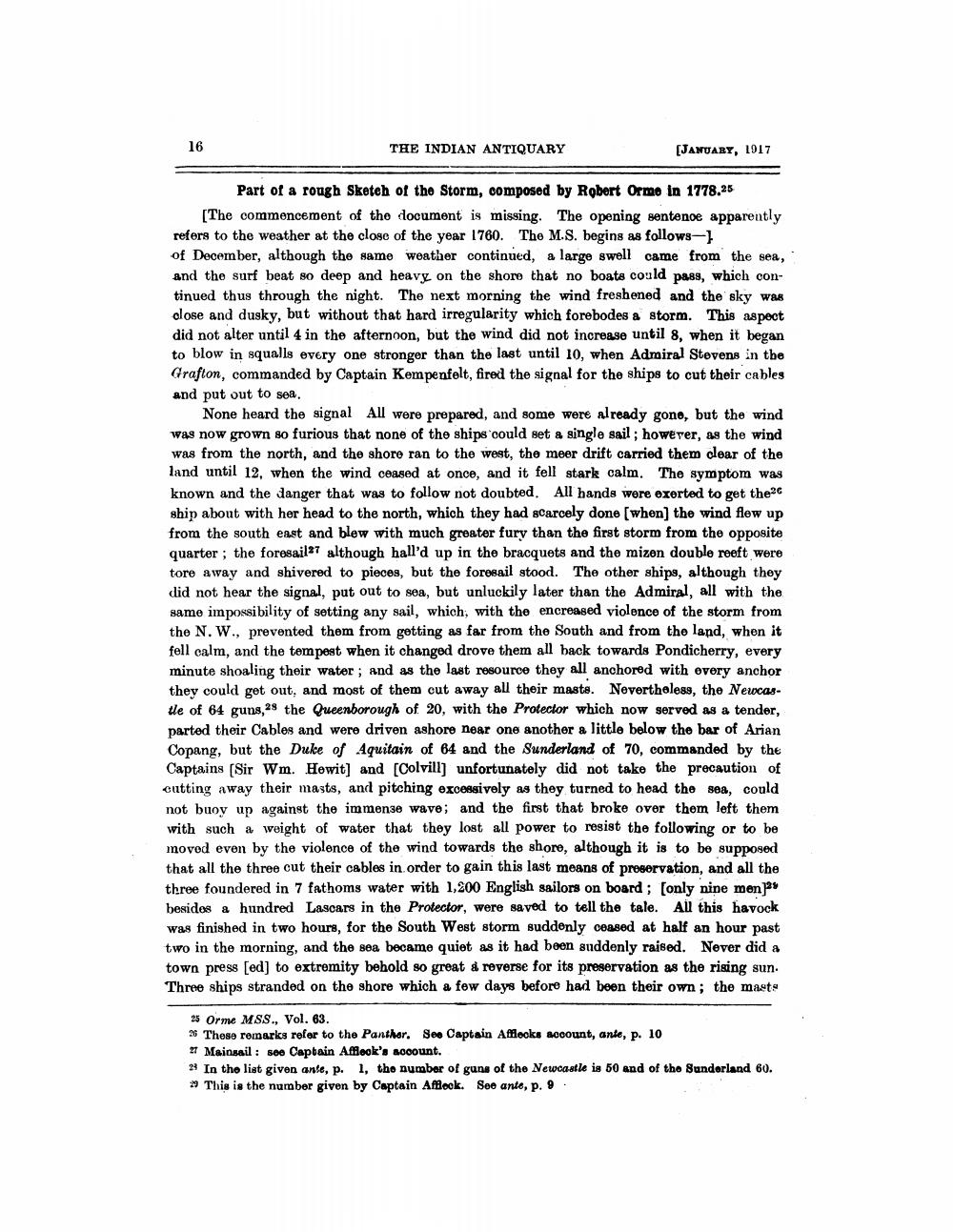________________
THE INDIAN ANTIQUARY
[JANUARY, 1917
Part of a rough Sketeh of the Storm, composed by Robert Ormo in 1778.25 [The commencement of the document is missing. The opening sentenoe apparently refers to the weather at the close of the year 1760. The M.S. begins as follows-1 of December, although the same weather continued, a large swell came from the sea, and the surf beat so deep and heavy on the shore that no boats could pass, which continued thus through the night. The next morning the wind freshened and the sky was close and dusky, but without that hard irregularity which forebodes a storm. This aspect did not alter until 4 in the afternoon, but the wind did not increase until 8, when it began to blow in squalls every one stronger than the last until 10, when Admiral Stevens in the Grafton, commanded by Captain Kempenfelt, fired the signal for the ships to cut their cables and put out to sea.
None heard the signal All were prepared, and some were already gono, but the wind was now grown so furious that none of the ships could get a single sail; however, as the wind was from the north, and the shore ran to the west, the meer drift carried them clear of the land until 12, when the wind ceased at once, and it fell stark calm. The symptom was known and the danger that was to follow not doubted. All hands were exerted to get the ship about with her head to the north, which they had scarcely done (when) the wind flew up from the south east and blew with much greater fury than the first storm from the opposite quarter; the foresail 27 although hall'd up in the bracquets and the mizon double reeft were tore away and shivered to pieces, but the foresail stood. The other ships, although they did not hear the signal, put out to sea, but unluckily later than the Admiral, all with the same impossibility of setting any sail, which; with the encreased violence of the storm from the N.W., prevented them from getting as far from the South and from the land, when it fell calm, and the tempest when it changed drove them all back towards Pondicherry, every minute shoaling their water; and as the last resource they all anchored with overy anchor they could get out, and most of them cut away all their maste. Nevertheless, the Newcastle of 64 guns,28 the Queenborough of 20, with the Protector which now served as a tender, parted their Cables and were driven ashore near one another a little below the bar of Arian Copang, but the Duke of Aquitain of 64 and the Sunderland of 70, commanded by the Captains (Sir Wm. Hewit] and [Colvill] unfortunately did not take the precaution of cutting away their masts, and pitching excessively as they turned to head the sea, could not buoy up against the immense wave; and the first that broke over them left them with such a weight of water that they lost all power to resist the following or to be moved even by the violence of the wind towards the shore, although it is to be supposed that all the three cut their cables in order to gain this last means of preservation, and all the three foundered in 7 fathoms water with 1,200 English sailors on board ; (only nine menja besides a hundred Lascars in the Protector, were saved to tell the tale. All this havock was finished in two hours, for the South West storm suddenly coased at half an hour past two in the morning, and the sea became quiet as it had been suddenly raised. Never did a town press [ed] to extremity behold so great à reverse for its preservation as the rising sun. Three ships stranded on the shore which a few days before had been their own; the masts
25 Orme MSS., Vol. 63. 26 These remarks refer to the Panthor. See Captain Afflecka account, ante, p. 10 27 Mainsail : see Captain Affleck's account. 2% In the list given ante, p. 1, the number of guns of the Newcastle is 50 and of the Sunderland 60. 29 This is the number given by Captain Affleck. See ante, p. 9.




